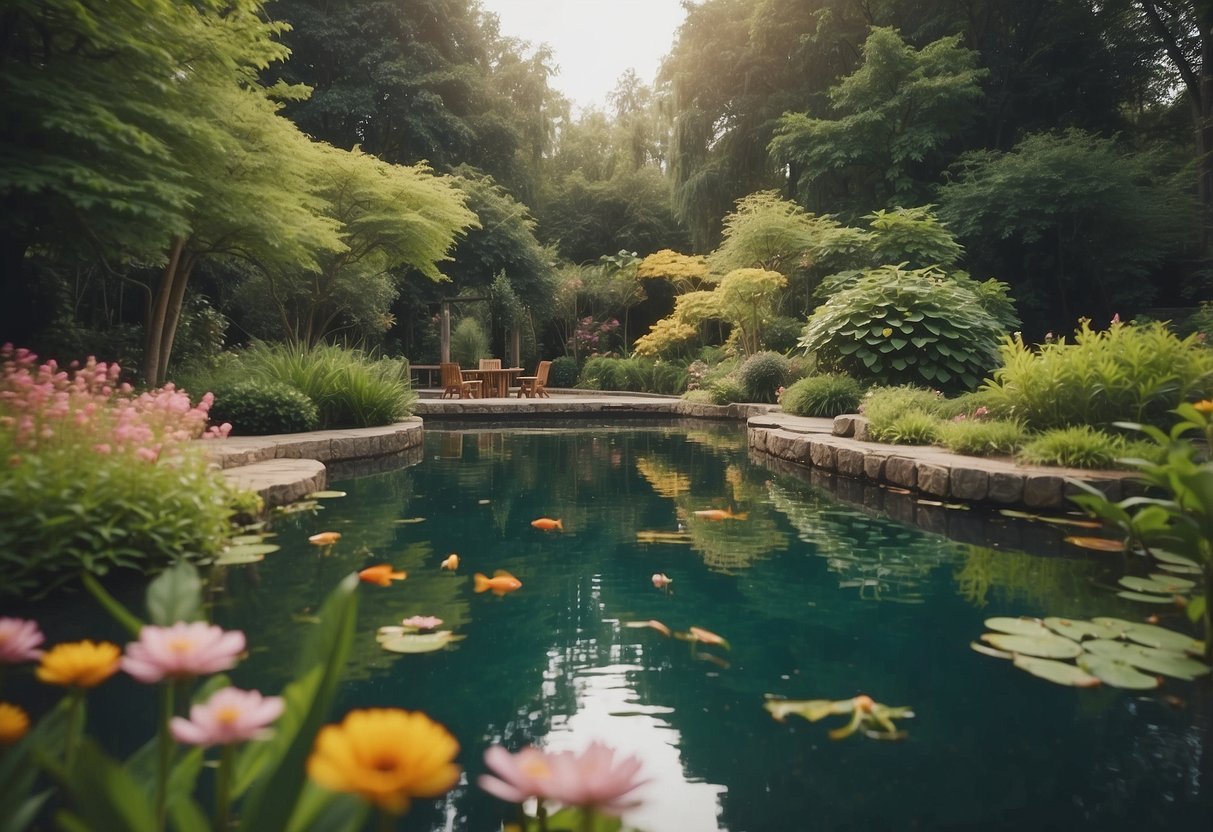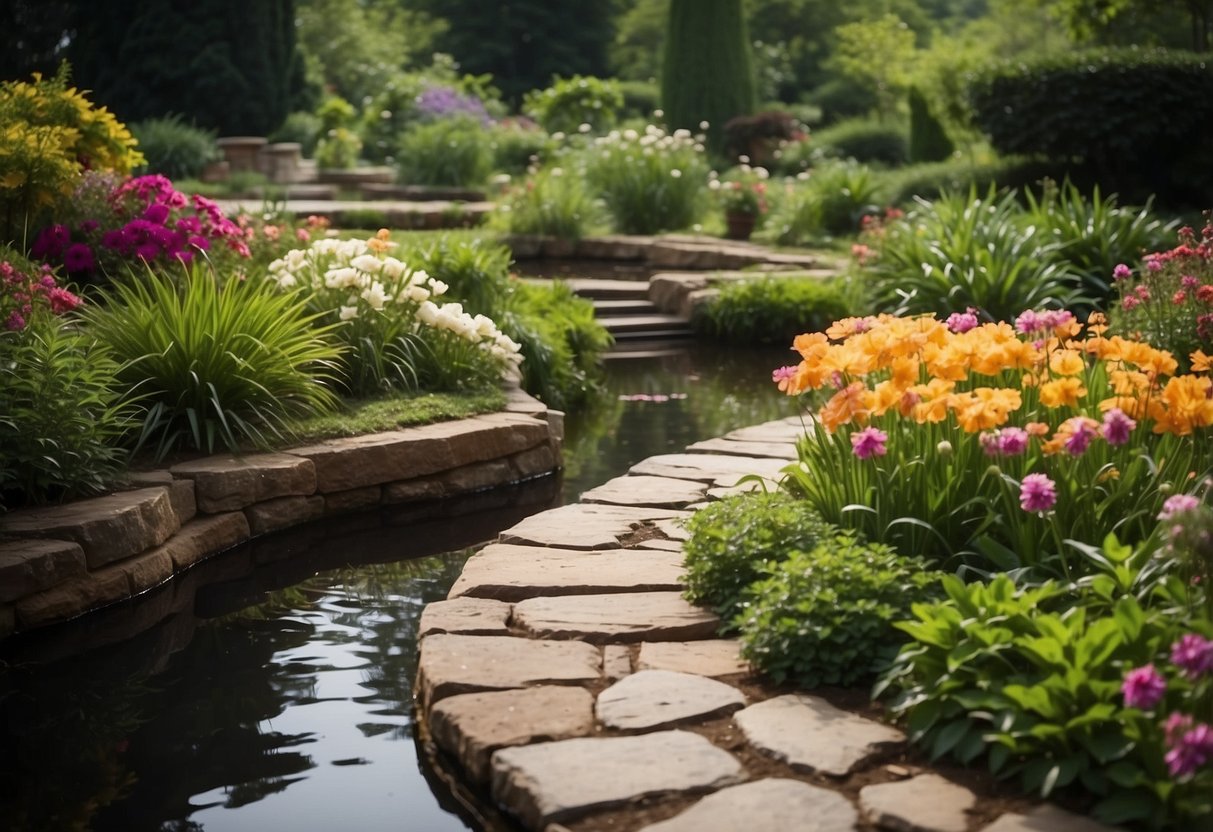Garden Pond Ideas: Creative Tips for Your Backyard Oasis
Adding a garden pond can transform your backyard into a tranquil oasis. Ponds bring a natural beauty to your space, offering a calming effect with the sound of flowing water and the sight of vibrant plants.

Wondering how to start your garden pond project? Our article will guide you through various ideas that cater to different budgets and yard sizes, making it easy to find an option that suits your needs. Whether you’re thinking of a small pond with a waterfall or a large, lush pond surrounded by plants, you’ll find plenty of inspiration to create a perfect garden retreat.
1) Floating Water Lilies

Floating water lilies are a beautiful addition to any garden pond. Their vibrant flowers and lush green leaves create a serene and calming atmosphere.
You can plant water lilies in pots with soil and gravel to keep them stable. Place the pots at the bottom of your pond.
As they grow, water lily leaves float gracefully on the surface, adding a touch of elegance to your pond.
These plants not only look amazing but also help keep the water clean by providing shade and reducing algae growth. Enjoy the tranquil beauty they bring to your garden pond!
2) Pondside Rock Garden

Creating a rock garden next to your pond can add beauty and texture to your outdoor space. Choose different sizes and shapes of rocks to make the area feel more natural.
Mix in some hardy plants like succulents and grasses around the rocks. This will make the garden look lush while being easy to maintain.
Consider adding a small pathway with stepping stones. This invites a closer look at the plants and rocks. For more ideas, you can explore various pond and rock garden designs for inspiration.
3) Koi Fish Habitat

Creating a koi fish habitat in your garden pond can be both fun and rewarding. Start by making sure the pond is deep enough, at least three feet, to keep the koi safe from predators and temperature changes.
Add plenty of plants like lotus or water lilies. Not only do they look beautiful, but they also produce oxygen and give koi places to hide.
Consider using a raised edge design to highlight your koi. This helps keep them secure while making it easier to admire their bright colors and graceful movements from different angles.
4) Waterfall Feature

Adding a waterfall feature to your garden pond can create a soothing sound and a beautiful focal point. Waterfalls help keep the water oxygenated, which is good for fish and plants.
When planning, choose a spot that’s easy to access. To get some inspiration, check out these 25 small ponds with waterfalls that are definitely worth adding to your yard.
For a natural look, stack rocks to direct the water flow. You might also like an Au Naturale design, which adds lush, natural elements to your garden.
5) Submerged LED Lights

Using submerged LED lights in your garden pond can make it look amazing at night. These lights are energy-efficient and can last a long time, making them a smart choice. You can find different kinds of LED lights, like those from Jebao, which can switch between white and multi-colored lights.
Submerged LED lights are great because they can highlight features like waterfalls and fountains, adding a magical touch. You can place them strategically to make your pond look even more beautiful.
6) Lotus Flowers

Adding lotus flowers to your garden pond can create a beautiful and serene environment. These flowers thrive in sunny spots and can handle 6 to 8 hours of direct sunlight each day.
Planting lotus is simple. You can start with seeds or tubers. Place the seeds in warm water and check for germination in about a week.
If using tubers, plant them in sandy loam soil and submerge the pot so the top is just below the water’s surface. With proper care, your lotus flowers will bloom and add a lovely touch to your pond.
7) Natural Stone Pathway

A natural stone pathway can add both beauty and function to your garden pond area. Using stones like limestone, granite, or slate gives a rustic and natural look.
You can lay the stones in a pattern or randomly for a more organic feel. Small gaps between stones can be filled with moss or low-growing plants for added charm. You might consider using stepping stones to traverse the pond itself, allowing you to enjoy the water up close.
8) Pond Skimmer

A pond skimmer is a useful tool for keeping your garden pond clean. It helps remove leaves, debris, and other unwanted particles from the water’s surface.
You can make your own skimmer by connecting a pump to a PVC pipe and attaching a skimmer net. For easy and budget-friendly options, consider looking at this DIY guide.
Adding a skimmer helps maintain clear water and a healthy environment for your fish and plants.
9) Fountain Head

Adding a fountain head to your garden pond can create a soothing sound of flowing water. It also helps aerate the water, which is great for fish and plants.
You can choose from various designs like a simple bubbling fountain or a decorative spout. Each option adds its own charm to your pond.
Explore more ideas on backyard pond designs to inspire your project.
10) Bamboo Water Spout

A bamboo water spout can add a touch of tranquility to your garden pond. It combines the soothing sound of water with a simple, natural aesthetic.
To build one, you’ll need some bamboo poles of different sizes. Cut the bamboo to length and drill holes for the water to flow through.
You can find detailed instructions and tips on how to build a bamboo water feature online. Bamboo spouts can be both a practical and decorative addition to your garden pond.
Designing Your Garden Pond

Designing a garden pond involves careful planning to ensure it complements your outdoor space. Focus on selecting the best location, determining the size and shape, and planning for depth and flow.
Choosing the Right Location
Picking the perfect spot for your pond is crucial. Aim for a location that gets a good mix of sunlight and shade. Too much sunlight can lead to algae growth, while too much shade can hinder plant growth.
Consider proximity to trees. Falling leaves can create debris, making maintenance harder. You want a spot that’s easily accessible for upkeep but also enhances the visual appeal of your garden.
Remember, a pond near seating areas allows you to enjoy the tranquil sound of water. Also, consider visibility from your home so you can enjoy the view from indoors too.
Determining the Size and Shape
The size and shape of your pond will depend on space and purpose. If you want a small, simple pond for plants, a round or oval design works well.
For larger ponds that may house fish like koi, consider more irregular shapes to mimic natural bodies of water. Always measure your space before starting and think about how it fits with the rest of your garden.
Make sure your pond is wide enough for fish to swim freely and deep enough to prevent the water from overheating. You might want to sketch a design on paper before starting the actual dig.
Planning for Depth and Flow
Depth plays a big role in the health of your pond. A depth of about 18-24 inches is suitable for most plant life. For fish ponds, aim for at least 3 feet to keep the water temperature stable and protect fish from predators.
Consider the pond’s flow as well. Adding a waterfall or a small fountain can help oxygenate the water, which is vital for fish and plants.
Make sure you have a good pump and filtration system to keep the water clean and healthy. Think about where the water will flow and how it circulates through different levels of your pond. This adds to both the beauty and functionality of your pond.
Maintaining Your Garden Pond

Maintaining your garden pond involves regular cleaning and managing algae growth to ensure a healthy environment for plants and fish. Keep your pond clean, and control algae to enjoy a thriving water feature.
Regular Cleaning Tips
To keep your garden pond looking its best, you should clean it regularly. Remove debris like leaves and twigs from the surface daily with a net. Use a pond vacuum to clean the bottom and sides once a week. This helps prevent buildup that can affect water quality.
Trim and remove any dead plants to keep your pond healthy. Overgrown plants can reduce oxygen levels in the water. Break up clustered aquatics like water lilies to promote better water circulation. Aim to keep at least 50% of the pond surface clear.
Filter maintenance is crucial. Clean or replace the filter media according to the manufacturer’s instructions to ensure it’s working efficiently. A well-maintained filter keeps the water clear and helps prevent issues with algae and debris.
Managing Algae Growth
Algae can quickly take over your garden pond, so it’s important to manage it effectively. Too much algae can harm plants and fish by reducing oxygen levels and blocking sunlight.
Install a UV clarifier to control algae blooms. This device uses ultraviolet light to kill algae cells, keeping the water clear and reducing the need for chemical treatments. Regularly check and clean the clarifier to keep it functioning properly.
Add aquatic plants like water lilies and lotus to your pond. These plants not only add beauty but also compete with algae for nutrients, helping to limit its growth. Covering around half of the pond’s surface with plants can naturally reduce algae.
Consider using barley straw or barley extract. These natural products release substances that inhibit algae growth without harming plants or fish. Place a small bundle of barley straw in the pond, or add liquid barley extract according to the instructions.
Enhancing Your Garden Pond

Enhancing your garden pond can turn it into a beautiful and lively focal point in your backyard. You’ll find valuable tips, from adding fish and aquatic plants to incorporating water features.
Adding Fish and Aquatic Plants
Adding fish like koi or goldfish adds color and life to your pond. Koi are great because they are hardy and can grow quite large. Goldfish are another popular choice because they are easy to care for and come in various colors.
Aquatic plants, such as water lilies and lotus, provide shade and reduce algae growth. These plants also create a natural look while supplying oxygen for the fish. Water lilies come in different sizes, making them suitable even for small ponds.
Submerged plants, like anacharis, help keep the water clean by absorbing nutrients. It’s also important to consider floating plants, like water hyacinth, which can provide cover for fish and help balance the pond ecosystem.
Incorporating Water Features
Water features like fountains and waterfalls can enhance the visual appeal of your pond. A fountain can create gentle water movement, which is not only soothing to the ears but also helps to oxygenate the water.
Waterfalls add a dynamic element by making the water flow naturally. They can be designed with rocks and plants to blend seamlessly into the surrounding landscape.
Adding a stepping stone path over or around your pond can create a magical experience, making it more inviting. Lighting, such as underwater LED lights, can illuminate the water at night, highlighting fish and plant life.
Install artificial features like statues or tiki torches to enhance the pond’s theme and complement the overall aesthetic. These elements can create a cohesive and attractive garden pond that stands out.







